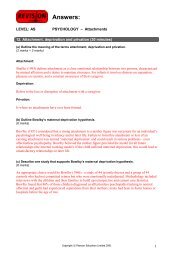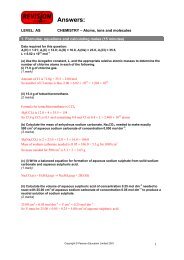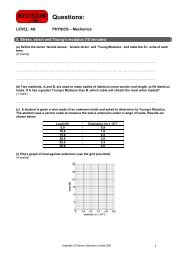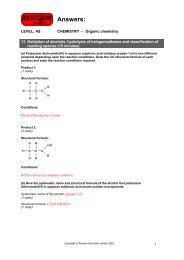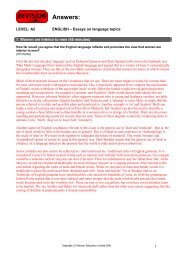7. Types of waves and their properties (12 minutes) - Pearson
7. Types of waves and their properties (12 minutes) - Pearson
7. Types of waves and their properties (12 minutes) - Pearson
You also want an ePaper? Increase the reach of your titles
YUMPU automatically turns print PDFs into web optimized ePapers that Google loves.
Answers:<br />
LEVEL: AS<br />
PHYSICS – Waves <strong>and</strong> Oscillations<br />
<strong>7.</strong> <strong>Types</strong> <strong>of</strong> <strong>waves</strong> <strong>and</strong> <strong>their</strong> <strong>properties</strong> (<strong>12</strong> <strong>minutes</strong>)<br />
(a)<br />
(i) Explain what is meant by the term 'progressive wave'.<br />
(1 mark)<br />
A progressive wave spreads out energy from the source vibration into the surrounding space.<br />
(ii) A radio wave <strong>of</strong> wavelength 5 x 103 m travels through a vacuum at 3 x 108 ms -1 . Calculate the<br />
frequency <strong>of</strong> this wave.<br />
(3 marks)<br />
v = fλ<br />
∴ f = v/λ<br />
= 3 x 10 8 ms -1 ÷ 5 x 10 3 m<br />
= 6 x 10 4 s -1<br />
= 6 x 10 4 Hz<br />
Watch out!<br />
If a question mentions an electromagnetic wave (e.g. radio, microwave, etc.) travelling in a vacuum, you should<br />
immediately realize that it will be travelling at 3 x 10 8 ms -1 .<br />
(b)<br />
(i) Explain what is meant by the term 'st<strong>and</strong>ing wave'.<br />
(2 marks)<br />
Under certain circumstances the energy <strong>of</strong> a wave can be prevented from spreading out. The positions <strong>of</strong> the<br />
peaks <strong>and</strong> troughs <strong>of</strong> these ‘st<strong>and</strong>ing’ or ‘stationary’ <strong>waves</strong> do not move.<br />
(ii) A st<strong>and</strong>ing wave is established in a string. Each antinode is separated from its neighbour by <strong>12</strong>.5 cm.<br />
What is the wavelength <strong>of</strong> the st<strong>and</strong>ing wave<br />
(2 marks)<br />
Antinodes are separated by λ/2 so λ = 25 cm<br />
Copyright © <strong>Pearson</strong> Education Limited 2001 1
Answers:<br />
LEVEL: AS<br />
PHYSICS – Waves <strong>and</strong> Oscillations<br />
(c)<br />
(i) Explain why the wave produced in this experiment is longitudinal.<br />
(1 mark)<br />
It is longitudinal because the vibrations causing the wave moving in the same direction as the wave motion.<br />
(ii) On the diagram label:<br />
a compression (C)<br />
a rarefaction (R)<br />
the wavelength (λ) <strong>of</strong> the wave<br />
(3 marks)<br />
By presenting information in a slightly unusual way (e.g. many teachers demonstrate slinky wires on a<br />
horizontal surface rather than hanging vertically as shown here) some questions can ‘weed out’ the weaker<br />
students.<br />
(Total marks <strong>12</strong>)<br />
Copyright © <strong>Pearson</strong> Education Limited 2001 2




